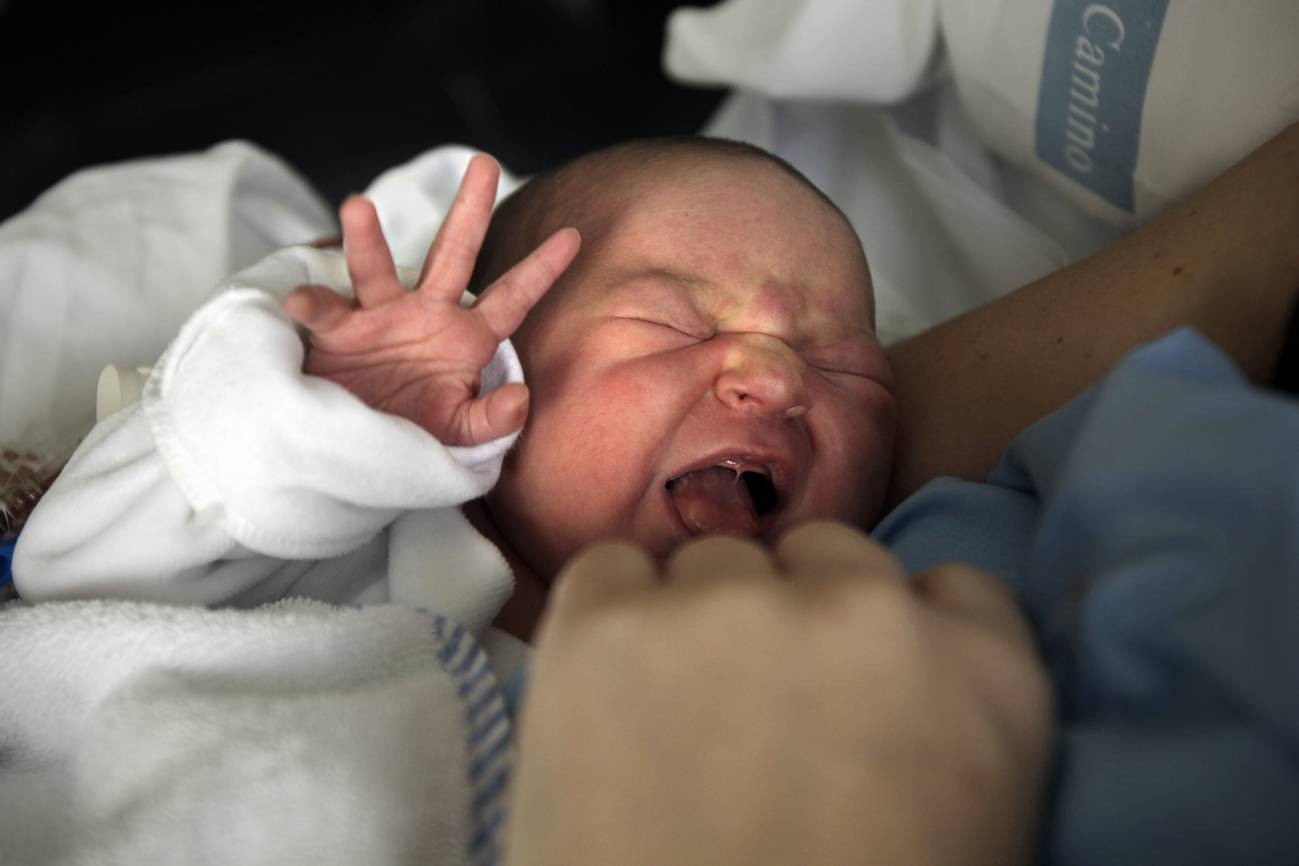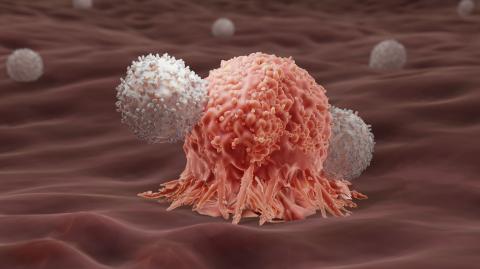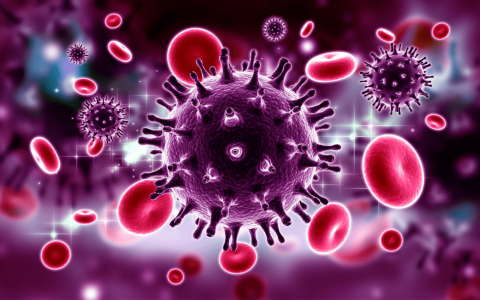Reactions: immunotherapy clinical trial improves prognosis of a type of leukaemia in infants
A phase 2 clinical trial has analysed the safety and efficacy of adding immunotherapy to traditional chemotherapy to treat a subtype of acute lymphoblastic leukaemia in children under one year of age. This subtype of leukaemia, although rare in absolute terms, is the most common in children of this age, and its prognosis in this age group had not improved in recent years. The immunotherapy used, a bispecific antibody that binds to tumour cells on the one hand and T lymphocytes on the other, improved two-year survival from 66% to 93% in treated patients, according to The New England Journal of Medicine (NEJM).

Luis Álvarez - bebés
Luis Álvarez-Vallina
Head of the Clinical Research Unit in Cancer Immunotherapy at CNIO-HMarBCN
This is a phase II, international, multicentre, prospective, prospective, well-designed clinical study of remarkable quality.
This work reaffirms the enormous potential of bispecific antibodies, and in particular of a type of bispecific antibody that recognises a tumour antigen and an activating molecule on the T lymphocyte. This type of bispecific T cell engager (TCE) antibody leads to the activation and proliferation of T lymphocytes, with the consequent release of cytokines and activation of cytotoxic functions.
The antibody used in this clinical trial (blinatumomab) is a small molecule called BiTE (Bispecific T cell Engager) that is designed to interact with CD19 on B cells and CD3 on T cells, and due to its compact structure is very efficient in the formation of conjugates between leukaemic cells and T cells. Blinatumomab was the first bispecific antibody approved for the treatment of haematological cancers. In December 2014, the US Food and Drug Administration (FDA) approved its clinical use in patients with relapsed or refractory B-cell acute lymphoid leukaemia (ALL).
This study demonstrates the potential of blinatumomab in patients younger than 1 year with newly diagnosed CD19+ B-precursor ALL with rearranged KLMT2A, a highly aggressive disease with a 3-year event-free survival of less than 40%. The bispecific antibody is applied in a 28-day cycle, and the study design was based on two hypotheses: that blinatumomab treatment should be applied early in treatment, and immediately after induction therapy to reduce the incidence of side effects and toxicity.
The follow-up period is short, but the clinical results are spectacular, with a 2-year disease-free survival of 81.6%, compared to 49.4% for conventional therapy.
Blinatumomab has demonstrated efficacy in different types of B malignancies since its initial approval in 2014. This work demonstrates the potential of bispecific antibodies in a type of paediatric leukaemia with a very poor prognosis, but in my opinion reaffirms the therapeutic validity of "T-redirection" strategies, which are the basis of the next revolution in cancer immunotherapy.
Blanca Herrero - bebés
Blanca Herrero Velasco
Paediatric oncohaematologist.
The work is published in the NEJM, one of the best scientific journals. The quality of the work is very good. The study is a multicenter study of major European pediatric cancer centers. The outcomes of patients with blinatumomomab are compared with their same cohort of patients treated with the same chemotherapy [without immunotherapy].
Blinatumomomab is an antibody used in adults with acute lymphoblastic leukemia (ALL) after refractory relapse. In the pediatric population there are several trials in early phases to test dose, safety and efficacy. In infants there are also studies that demonstrate that it is a safe drug.
This study compares survival when adding a cycle of blinatumomab to conventional chemotherapy with good results. Among the limitations are that the comparison is with a retrospective cohort and that the number of patients is not particularly large.
ALL in the infant is rare. Of patients under one year of age with ALL, 80% have KMT2A gene rearrangement. Patients with this rearrangement have a worse prognosis than those without.
They are patients with a lot of toxicity from treatment, many infections and mortality associated with chemotherapy complications, added to the fact that they have a higher relapse rate than pediatric patients older than one year with ALL. These relapses are early (during the treatment itself or in the first year or two after treatment).
The use of blinatumomab is safe and effective in improving infant survival.
The data in this article are important in the design of the upcoming INTERFANT 21 protocol [phase 3 trial], which will use blinatumomab in the treatment of these infants in combination with chemotherapy.
Pablo Velasco - bebés
Pablo Velasco Puyó
Doctor in the Paediatric Oncology and Haematology Department at Vall d'Hebron Hospital and associate professor in the Paediatrics Department at the Autonomous University of Barcelona
It is a phase II study that has been accepted in the journal NEJM, which demonstrates the quality, as it is a journal with a very demanding peer review.
It has introduced immunotherapy in the first line of one of the most aggressive and poorly responsive leukaemias in paediatrics, and has achieved a 60% greater disease-free survival [30 percentage points] in two years with manageable toxicity. I think these data are good news, although they have to be validated in phase 3, which we hope will soon open in several countries, including Spain.
The main limitations are the number of patients and the non-randomisation of blinatumomab, both derived from the rarity of this disease, with probably 7-10 cases per year [in Spain]. As for the follow-up period, it is generally short considering that there may be late relapses, although this may not be so important in this leukaemia, as it tends to relapse early.
Susana Rives- bebés
Susana Rives
Specialist doctor in charge of the Leukaemia and Lymphoma Unit at the Paediatric Oncology Department of the Hospital Sant Joan de Déu Barcelona.
The study is of good quality and very important.
80-90% of children with acute lymphoblastic leukaemia can be cured with chemotherapy. However, the prognosis in infants (babies under 12 months) is much worse, with a chance of cure of less than 60%. Over the past 20 years, these results have not improved.
This international study shows that adding blinatumomab (a type of immunotherapy) to chemotherapy is safe and is associated, at least in the short term, with a large improvement in survival in infants (babies under 12 months) with acute lymphoblastic leukaemia.
When comparing the results of this study with those obtained in previous studies that did not use blinatumomab, the probability of disease-free survival at two years increases from 49.4% to 81.6%. Although more follow-up time is needed to speak of cure, it should be noted that among infants who relapsed, the vast majority (90%) did so within the first two years.
Blinatumomab had already been shown to be a safe and effective drug in children older than 1 year and adults with relapsed or poorly responsive acute lymphoblastic leukaemia (persistence of minimal residual disease). It was not known whether it would be effective and tolerated in infants. One of the possible side effects of blinatumomab is nervous system toxicity (such as tremor, seizures). In infants, it was important to rule out that it might be worse tolerated. In 30 patients, none have had to discontinue treatment due to neurological toxicity or otherwise.
The implication is great, as it makes it advisable to use blinatumomab in the treatment of infants with ALL.
The limitations are that it is a study with a small number of patients (30 infants) and that there has not been a randomised comparison of treatment with chemotherapy alone versus chemotherapy + blinatumomab. However, given the poor prognosis of these children with chemotherapy and the data on blinatumomab in children older than 1 year and adults, it was very difficult (ethically) to randomise whether or not to give blinatumomab. On the other hand, even though 30 is a small number, leukaemia in children under 1 year is a very rare type of leukaemia and makes it difficult to have high numbers in a short time.
It will be able to benefit 80% of infants with acute lymphoblastic leukaemia. In absolute numbers this is a very low number, because the incidence of ALL in infants is very small. But among patients with this minority disease, it will benefit most of them.
The follow-up time is short and it is true that it will have to be confirmed with results at longer follow-up. However, it is a very aggressive type of leukaemia and most relapses and deaths due to toxicity occur in the first two years, so it is a result that deserves to be taken into account and this treatment should be included in the first line of treatment. However, it will be necessary to re-evaluate, with further follow-up, whether these promising results are maintained.
"I have received travel and/or advisory board support from several pharmaceutical companies with immunotherapy treatments, including Amgen (blinatumomab), Novartis, Bristol-Meyer-Squibb, Kite and Cellectis".
Josep Maria Ribera - bebés
Josep Maria Ribera
Head of the Haematology Department at ICO Badalona
This is a multicentre, phase 2 clinical trial involving prestigious European groups with a long tradition in the treatment of childhood acute lymphoblastic leukaemia (ALL). Given the rarity of the KMT2A-rearranged ALL subtype, a phase 3 trial was not possible, so the results of this study were compared with those of previous studies in patients with the same type of ALL.
Previous evidence available in infants with LAL with KMT2A rearrangement was disappointing. In fact, this subtype is the one with the worst prognosis (50% survival) and where no treatment advances had been reported in the last 10 years. Hence the importance of the results of this clinical trial (90% survival), clearly superior to what was available until now, as is perfectly reflected in the published work. This was achieved by simply adding one cycle of blinatumomab to the classic chemotherapy treatment.
This small modification has led to a large improvement in survival, demonstrating the high efficacy of immunotherapy with the monoclonal antibody. The clinical implications of this are clear.
Limitations are cited by the authors in their study. There are mainly three. First, the small number of patients (30). Secondly, the relatively short follow-up (median 2 years). Finally, the fact that it is not a randomised study, i.e. comparing patients treated with and without blinatumomab within the same study.
These limitations are logical in the treatment of a very rare subtype of ALL. On the other hand, although the follow-up is short, it is a well-known fact that in ALL with KMT2A rearrangement, relapses, if any, occur early and would therefore be detected with the follow-up available in this study.
The results of this study apply only to a very small group of ALL occurring mainly in infants, representing 5% of all childhood ALL. The great merit in my opinion is that it places the survival of this group, characteristically with a poor prognosis, at the level of other subgroups of childhood ALL with a good or intermediate prognosis. Moreover, it demonstrates the great power of immunotherapy, with blinatumomab in this case, in the treatment of ALL. This is not unique to this subtype of ALL. The efficacy of this drug administered first line is also being demonstrated in adults.
Antonio Pérez - bebés
Antonio Pérez Martínez
Head of the Paediatric Haematology-Oncology Department at the Hospital Universitario La Paz.
This is a very important issue for several reasons:
There is evidence in clinical trials and scientific recommendations that recommend blinatumomab for example in post-treatment relapses, to induce remission and then go on to a transplant and even as a bridge to CAR-T therapy.
This study associated with chemotherapy improves the results of chemotherapy (iNFANT protocol).
Hopefully, these studies will improve the accessibility of these immunotherapies, which in our country is vetoed by the pharmacy services.
We have just published our experience with acute lymphoblastic leukaemia (ALL) in young children (34 patients), and these are results that need to be improved with strategies combined with chemotherapy, such as immunotherapy.
As these are drugs with a high economic impact, access is being blocked in many hospitals, and when we ask for them, the pharmacy services mostly deny access.
Evidence such as this will help us to optimise it.
Ignacio Melero - bebés
Ignacio Melero
Professor of Immunology at the University of Navarra, CIMA researcher and co-director of the Department of Immunology and Immunotherapy at the Clínica Universidad de Navarra.
It is a work of exceptional quality and clearly a game changer in medical practice.
It applies to paediatric patients. Evidence was previously available in adult patients and in children after chemotherapy failure. Here the bispecific antibody is used in the first line of treatment with a very good safety and efficacy profile, although only evidence for high-risk patients with KMT2A gene rearrangement.
There are still a certain percentage of patients who relapse and the reasons for relapse should be studied in depth, considering first-line treatment combinations for this subgroup of patients.
The follow-up period with detection of minimal residual disease is very significant. As time goes on, the patients in this study who remain in follow-up will allow further data to be collected.
It is a treatment that in principle corresponds to patients with the KMT2A rearrangement, which represents 2-4% of paediatric patients.
- Research article
- Peer reviewed
- Clinical trial
- People


